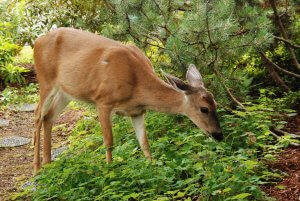How to Protect Your Lawn From Deer Damage
The opinion that deer are beautiful is almost unanimous. Unfortunately, however, deer like to eat plants, including ornamental trees and shrubs. While it’s not possible to keep deer out of your yard entirely, combining a few of these methods will encourage them to dine elsewhere.

Protect Younger Trees. Autumn puts deer in the mood for love. Male deer mark their territory by rubbing scent glands in their foreheads on trees. The smell then attracts does to the area. An unfortunate side effect of this ritual is damage caused by their antlers. If a tree’s diameter is three inches or fewer, it is especially vulnerable. Most garden supply stories and nurseries sell wrap that is designed to protect trees from antler damage.
Check the List. Did you know that tulips are a favorite treat among growing fawns? By contrast, deer turn up their muzzles at another popular spring flower, daffodils. The University of Georgia Extension Office has created a reference guide to the plants that deer favor and the ones they avoid. You’re not necessarily limited to those on the latter list; if you’re informed, you can provide extra protection for plants at risk.
Make a Plant Plan. If you love the same plants that deer seek out, like English ivy, flowering dogwood, and tulips, place them near your house. Deer prefer to stay away from humans whenever possible. To safeguard them further, intersperse them with a few selections from the list of plants that deer dislike.
Add Slopes and Fences. Most people who add steep slopes and terraced gardens to their landscapes do so for visual reasons, but these features also discourage deer. They are jumpers, not climbers, and gravitate towards low and level ground. You can counter jumping with a fence, but it must completely block the view from the side on which deer approach. They will not jump over an obstacle if they can’t see where they’re going to land.
Scare Them Away. Windmills, sculptures that respond to wind, pinwheels and flags — anything that air can move in unpredictable ways will startle deer.
Clean Up Crops. Deer are also happy to eat the plants we grow for food. It might be tempting to postpone harvest for a day or two, or to leave the last few vegetables of the season in place when you’ve had enough. To deter deer from taking advantage, collect your crops as soon as they’re ripe, including those you don’t plan to eat.
While no single method can guarantee that your ornamental trees, shrubs, and other plants will be safe from deer, a combination of these deterrents will encourage them to seek out other picnic spots.


